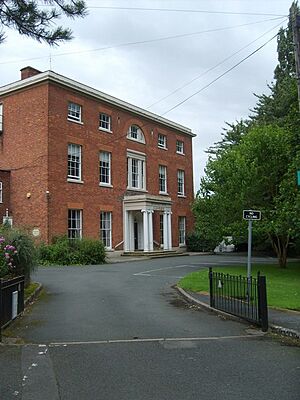Broadfield House Glass Museum facts for kids

The historical frontage
|
|
| Established | 1980 |
|---|---|
| Location | Kingswinford, West Midlands |
| Type | Art, craft and social history museum |
Broadfield House was once a special place in Kingswinford, West Midlands, England. It was home to a glass museum and a studio where artists made glass. The museum was owned by Dudley Council. It closed its doors on September 30, 2015.
The museum showed off many different glass objects. These items dated from the 1600s all the way to modern times. They were displayed in nine different rooms. You could also see paintings that showed how glass was made. The museum also had tools and other items from the glass industry. Many special events and temporary art shows happened there. Visitors could buy souvenirs, books, and unique glass items in the shop.
Today, the amazing glass collection from Broadfield House is displayed at the Stourbridge Glass Museum. This new museum opened on April 9, 2022.
Contents
History of Broadfield House
The building itself has a long and interesting past. It started as a simple two-story farmhouse. This was in the mid-to-late 1700s. There was also a barn, which is now the Hot Glass Studio. This shows that the area was once open farmland.
In the early 1800s, the house changed a lot. It became a much grander home. A new three-story section was added. This part had big windows and a fancy entrance. This new entrance faced the opposite way from the original farmhouse.
New Owners and New Uses
In 1943, a man named Kenneth George MacMaster bought the house. He was an engineering contractor. The next year, he sold it to Dennis Smith. Mr. Smith was the last private owner. He lived there with his family until 1949.
After that, the house was used for different public services. In 1949, Staffordshire County Council bought it. They used it as a Mothercraft Hostel. This was a place to help new mothers and their babies.
Later, in 1966, the house became part of Dudley Council. By 1969, Broadfield House was turned into a home for older people. However, it was not a good fit. It had 44 stairs and no lift, which made it hard for residents.
Becoming a Museum
Dudley Council closed the old people's home in 1974. They started looking for a new use for the building. In 1976, someone had the idea to make it a glass museum. It would be a new home for the Council's glass collections. These collections were from Brierley Hill and Stourbridge.
Many people in Brierley Hill and Stourbridge did not like this idea. They wanted their glass collections to stay in their towns. But in the end, the decision to create the museum won by just one vote! Work to change the house began in 1979. The Broadfield House Glass Museum officially opened on April 2, 1980. Princess Michael of Kent attended the opening ceremony.
As mentioned, the museum closed on September 30, 2015. Its amazing collection is now at the Stourbridge Glass Museum.
Exhibitions and Art
The museum often held special art shows. These shows featured glass art from local, national, and even international artists. You could see both old and new glass artworks.
The Hot Glass Studio
Broadfield House also had a Hot Glass Studio. This studio was supported by The Hulbert Group. It was a place where new and experienced glass-blowers could create their art. Glass-blowing is a way of shaping hot glass using air.
Archives and Library
The museum also kept important historical records. These included old pattern books, catalogues, and invoices from glass companies. There was also a large collection of photos and recordings. These helped people learn about the glass-making process and the people who worked in the industry.
The museum also had a huge library of books about glass. This included the entire library of Robert Charleston. He used to be in charge of glass and ceramics at the Victoria & Albert Museum. His collection had about 700 books. It also included his own papers and other historical materials.
Both the library and the archives are still cared for by the Dudley Museum Service today.

